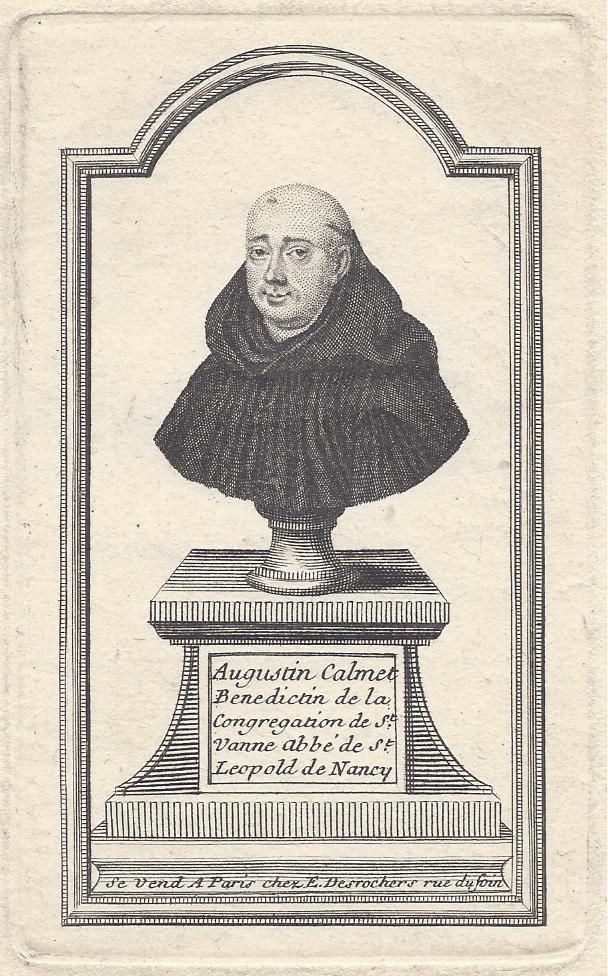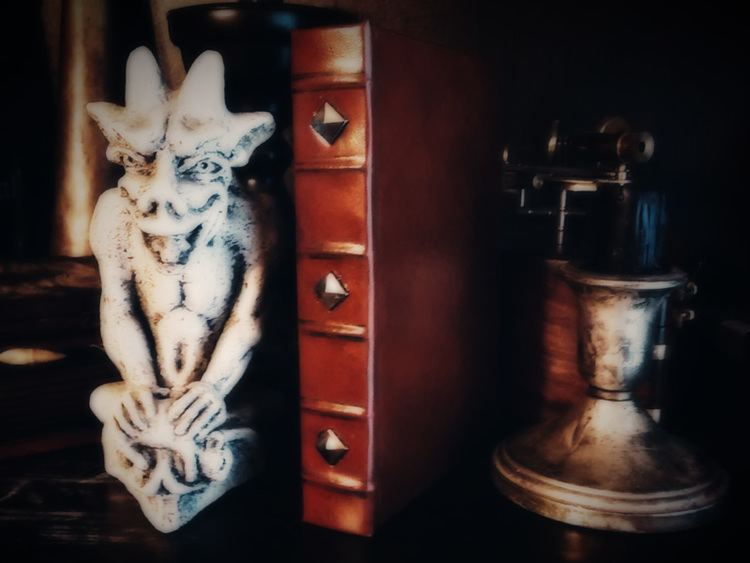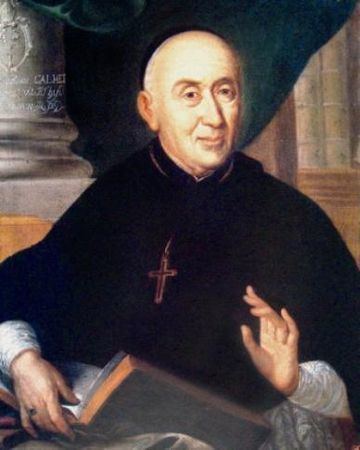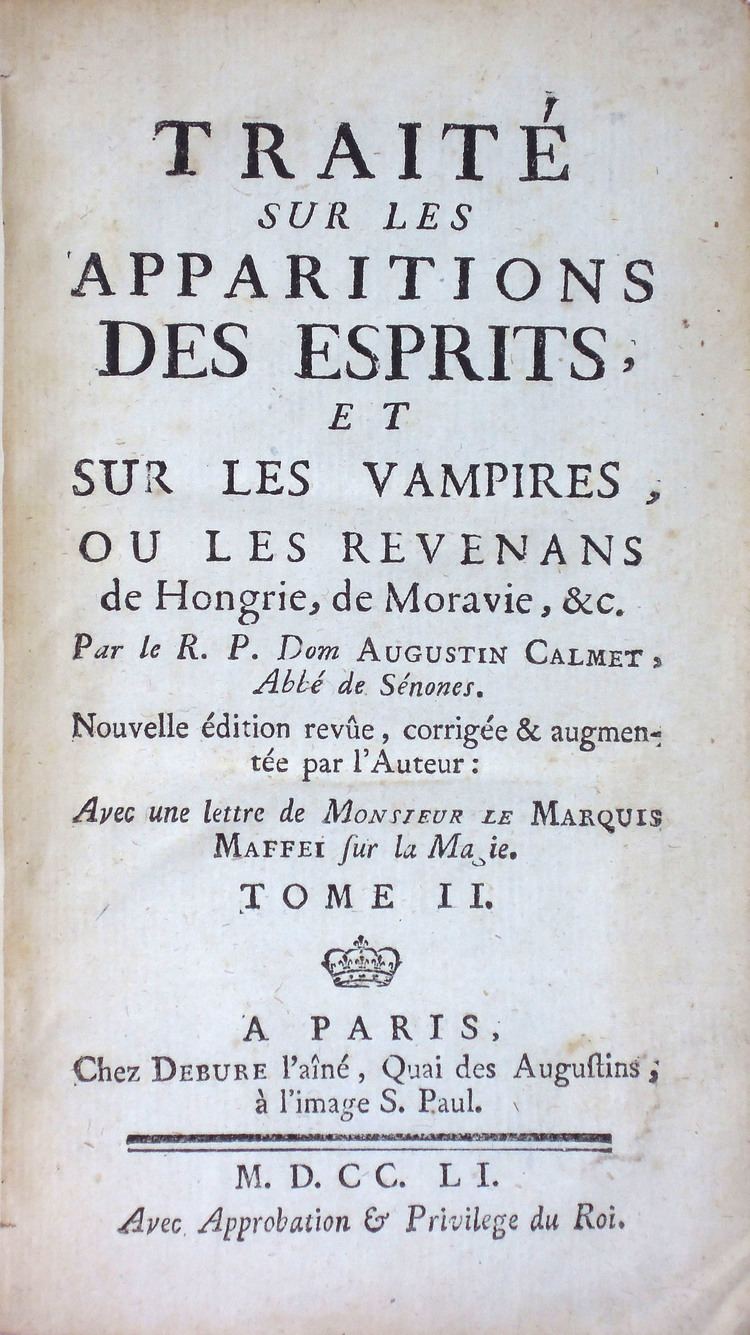Name Antoine Calmet Ordination March 17, 1696 | ||
 | ||
Other posts People also search for Henry Christmas, Charles Taylor, Clive Leatherdale Books The Phantom World: Or, Treatise on Vampires & Revenant, The Phantom World, Calmet's Dictionary of the Hol | ||
Antoine augustin calmet
Antoine Augustin Calmet, O.S.B. (26 February 1672 – 25 October 1757), a French Benedictine monk, was born at Menil-la-Horgne, then in the Duchy of Bar, part of the Holy Roman Empire (now the French department of Meuse, located in the region of Lorraine).
Contents
- Antoine augustin calmet
- Antoine Augustin Calmet Wikipedia audio article
- Comments on the Bible
- Other works
- References

Calmet was a pious monk as well as a learned man, and one of the most distinguished members of the Congregation of St. Vanne. In recognition of these qualities he was elected prior of Lay-Saint-Christophe in 1715, Abbot of St-Leopold at Nancy in 1718, and of Senones Abbey in 1729. He was twice entrusted with the office of Abbot General of the congregation. Pope Benedict XIII wished to confer episcopal dignity upon him, but his humility could not be brought to accept the honour.

Calmet was greatly admired by the philosopher Voltaire, who visited the abbey on several occasions.
He died at Senones Abbey, in the Vosges, near Saint-Die, on 25 October 1757.
Antoine Augustin Calmet | Wikipedia audio article
Comments on the Bible

Calmet was educated at the Benedictine priory of Breuil in the town of Commercy, and in 1688 joined the same Order at the Abbey of Saint-Mansuy at Toul, where he was admitted to profession on the 23 October of the following year. After his ordination, 17 March 1696, he was appointed to teach philosophy and theology at the Abbey of Moyenmoutier. Here, with the help of his brethren, he began to gather the material for his commentary of the Bible, which he completed at Munster in Alsace where he was sent in 1704 as sub-prior and professor of Biblical exegesis.

The first volume appeared in Paris in 1707 with the title Commentaire litteral sur tous les livres de l'Ancien et du Nouveau Testaments (A literal Commentary on all the Books of the Old and New Testaments); the last of the twenty-three quarto volumes, owing to various delays, was published only in 1716. To satisfy the demand for the work a second edition in twenty-six volumes quarto was issued 1714–1720, and a third, enlarged, edition in nine volumes folio 1724–1726. A Latin translation by J. D. Mansi was published at Lucca, 1730–1738, in nine folio volumes, with new editions at Augsburg (1756, eight volumes folio) and Wurzburg (1789, nineteen volumes quarto); another Latin translation by F. Vecelli appeared at Venice and Frankfurt (1730, six volumes folio). This shows how much the commentary was esteemed. But while it was received with high praise, even by Protestants, critics were not wanting, among whom may be mentioned the Oratorian Richard Simon. It cannot be denied that in spite of its merits and great erudition it is in some respects open to criticism. Difficult passages are often passed over lightly, and too frequently different explanations of a text are set down without a hint to the reader as to which is the right or preferable one.

The work inaugurated a new method of exegesis. Its author departed from the custom of giving allegorical (mystical) and tropological (moral) interpretations besides the literal. The most valuable part of the commentary were the introductory prefaces to the several books and 114 learned dissertations on special topics. These he published separately with nineteen new ones in three volumes, under the title Dissertations qui peuvent servir de prolegomenes a l'Ecriture Sainte (Paris, 1720). The collection met with such success that two editions were printed at Amsterdam in 1722, the title being changed to Tresors d'antiquites sacrees et profanes. It was translated into English (Oxford, 1726), Latin (by Mansi, Lucca, 1729), Dutch (Rotterdam, 1728), German (Bremen, 1738,1744, and 1747) and Italian.
Other works

In the meanwhile he had prepared two other works closely connected with Biblical exegesis: (1) Histoire de l'Ancien et du Nouveau Testament et des Juifs (Paris, 1718), which went through several editions, and was translated into English (London, 1740), German (Augsburg, 1759) and Latin (ib., 1788); (2) Dictionnaire historique, critique, chronologique, geographique et litteral de la Bible (Paris, 1720, two vols. folio), a supplement (also folio) was added in 1728. An improved and enlarged edition in four folio volumes was published in 1730, which has several times been reprinted, the last time in Migne, Encyclopedie theologique, I-IV. It, too, was translated into Latin and the principal European languages. The English translation by D'Oyley and John Colson (1732), revised and with additions by Taylor (1795), went through many editions in a larger and compendious form.
In his later years Calmet published some further Biblical dissertations in the Bible de Vence (1742). Among his other published works may be mentioned: (1) Histoire universelle sacree et profane, (Universal History, Sacred and Profane) depuis le commencement du monde jusqu'a nos jours (Strasbourg, 1735, quarto), in which he follows the ideas enunciated in Bossuet's Discours sur l'histoire universelle; (2) Histoire ecclesiastique et civile de la Lorraine (Ecclesiastical and Civil History of Lorraine) (Nancy, 1728), of great value for the history of that province; (3) Bibliotheque lorraine (A Catalogue of the Writers of Lorraine) (Nancy, 1751), containing his autobiography (pp. 209–217); (4) Commentaire litteral historique et moral sur la regle de Saint Benoit (A Literal, Moral, and Historical Commentary on the Rule of Saint Benedict) (Paris, 1734).
His two-volume study "Treaty on the Apparitions of spirits and Vampires, or ghosts of Hungary, Moravia, & c.", published in 1751, ambiguously considered the possibility of the existence of vampires, although not stating it explicitly.
Calmet wrote a noted history of the Duchy of Lorraine, as well as a history of the Abbey of Senones, which was still in manuscript form at the time of his death.
